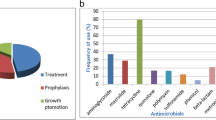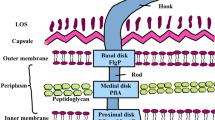Abstract
In this study, 51 piglets originating from five different sows were included in the investigations. The animal source of all sows had a history of Clostridium perfringens type A (β2) infection. The piglets of three sows (n = 31) were experimentally infected with Isospora suis within the first 4 h after birth and were randomly assigned to the treatment group or the sham-dosing group. The piglets of the two remaining sows (n = 20) served as I. suis-uninfected controls. Twelve hours post-infection, the animals in the treatment group (n = 15) were treated with toltrazuril (20 mg/kg BW, Baycox® 5% suspension). During an observation period of 14 days faecal consistency, faecal oocyst counts, faecal germ counts, mortality, body weight development and clinical status were recorded. One piglet per study group and litter was necropsied, and intestinal tissue samples were taken for histopathological investigations and in situ hybridisation on study days (SDs) 3 and 14. I. suis-infected but untreated piglets showed clinical disease resulting in liquefaction of faeces and decreased body weight development. In 59.2% of the observations, I. suis-infected but untreated piglets showed abnormal faecal consistencies whereas only 12.0% or respectively 4.4% of the faecal samples had a pasty consistency in the I. suis-infected–treated or in the control animals. The mean body weight at the end of the study was 3.37 kg in the I. suis-infected but untreated piglets while the average body weight in the I. suis-infected–treated animals was calculated as 4.42 kg and the control animal’s mean body weight was 4.45 kg. Moreover, mortality, occurring between SDs 8 and 14, in this study group was 38.5% (n = 5), with 30.8% (n = 4) died from necrotic enteritis. In contrast, no piglets died in the I. suis-uninfected control group or in the toltrazuril-treated study group. The results of this study corroborate the hypothesis that simultaneous infection with I. suis and C. perfringens type A soon after birth leads to distinct interactions between the two pathogens and result in an increase in clinical disease, mortality and metabolically active C. perfringens type A.






Similar content being viewed by others
References
Amann RI, Binder BJ, Olson RJ, Chisholm SW, Devereux RStahl DA (1990) Combination of 16s rRNA-targeted oligonucleotide probes with flow cytometry for analyzing mixed microbial populations. Appl Environ Microbiol 56:1919-1925
Amann RI, Ludwig W, Schleifer K-H (1995) Phylogenetic identification and in situ detection of individual microbial cells without cultivation. Microbiol Rev 59:143–169
Baba E, Ikemoto T, Fukata T, Sasai K, Arakawa A, McDougald LR (1997) Clostridial population and the intestinal lesions in chickens infected with Clostridium perfringens and Eimeria necatrix. Vet Microbiol 54:301–308
Bach U, Kalthoff V, Mundt HC, Popp A, Rinke M, Daugschies A, Luttge B (2003) Parasitological and morphological findings in porcine isosporosis after treatment with symmetrical triazintriones. Parasitol Res 91:27–33
Collier CT, Hofacre CL, Payne AM, Anderson DB, Kaiser P, Mackie RI, Gaskins HR (2008) Coccidia-induced mucogenesis promotes the onset of necrotic enteritis by supporting Clostridium perfringens growth. Vet Immunol Immunopath 122:104–115
Daugschies A, Bialek R, Joachim A, Mundt HC (2001) Autofluorescence microscopy for detection of nematode eggs and protozoa, in particular Isospora suis, in swine feces. Parasitol Res 87:409–412
Franks AH, Harmsen HJ, Raangs GC, Jansen GJ, Schut F, Welling GW (1998) Variations of bacterial populations in human feces measured by fluorescent in situ hybridization with group specific 16s rRNA-targeted oligonucleotide probes. Appl Environ Microbiol 64:3336-3345
Harleman JH, Meyer RC (1984) Life cycle of Isospora suis in gnotobiotic and conventionalized piglets. Vet Parasitol 17(1):27–39
Harleman JH, Meyer RC (1985) Pathogenicity of Isospora suis in gnotobiotic and conventionalised piglets. Vet Rec 116(21):561–565
Krüger M, Schroedl W, Krüger M, Schwarz S, Mengel H, Daugschies A, Swidsinski A, Mundt HC, Westphal B (2010) Prakt Tierarzt 91:774–784
Kuhnert Y, Schmäschke R, Daugschies A (2006) Comparison of different methods for examining the feces of suckling piglets for Isospora suis. Berl Munch Tierarztl Wochenschr 119(7–8):282–286
Maes D, Vyt P, Rabaeys P, Gevaert D (2007) Effects of toltrazuril on the growth of piglets in herds without clinical isosporosis. Vet J 173:197–199
Mavromatis I, Kyriakis CS, Alexopoulos C, Kritas SK, Tzika ED, Kyriakis SC. Efficacy and cost benefit study on the use of toltrazuril for the control of neonatal coccidiosis in pigs due to Isospora suis under field conditions. In: Proceedings of the 18th Congress of the International Pig Veterinary Society, Hamburg, Germany, 2004, 323
McDonel JL (1986) Toxins of Clostridium perfringens type A, B, C, D and E. In: Dorner F, Drews H (eds) Pharmacology of bacterial toxins. Pergamon, Oxford, pp 477–517
Mundt HC, Joachim A, Daugschies A, Zimmermann M (2003) Population biology studies on Isospora suis in piglets. Parasitol Res 90:158–159
Mundt HC, Joachim A, Becka M, Daugschies A (2006) Isospora suis: an experimental model for mammalian intestinal coccidiosis. Parasitol Res 98:167–175
Mundt HC, Mundt-Wüstenberg S, Daugschies A, Joachim A (2007) Efficacy of various anticoccidials against experimental porcine neonatal isosporosis. Parasitol Res 100:401–411
Niestrath M, Takla M, Joachim A, Daugschies A (2002) The role of Isospora suis as a pathogen in conventional piglet production in Germany. J Vet Med B Infect Dis Vet Public Health 49(4):176–180
Poulsen LK, Ballard G, Stahl DA (1993) Use of rRNA fluorescence in situ hybridization for measuring the activity of single cells in young and established biofilms. Appl Environ Microbiol 59:1354–1360
Robinson Y, Morin M, Girard C, Higgins R (1983) Experimental transmission of intestinal coccidiosis to piglets: clinical, parasitological and pathological findings. Can J Comp Med 47:401–407
Songer JG (1996) Clostridial enteric disease of domestic animals. Clin Microbiol Rev 9:216–234
Songer JG, Anderson MA (2006) Clostridium difficile: an important pathogen of food animals. Anaerobe 12(1):1–4
Songer JG, Uzal FA (2005) Clostridial enteric infections in pigs. J Vet Diagn Invest 17(6):528–536
Stuart BP, Lindsay DS, Ernst JV, Gosser HS (1980) Isospora suis enteritis in piglets. Vet Pathol 17(1):84–93
Swidsinski A, Loening-Baucke V, Lochs H, Hale LP (2005) Spatial organization of bacterial flora in normal and inflamed intestine: a fluorescence in situ hybridization study in mice. World J Gastroenterol 11:1131–1140
Vítovec J, Koudela B (1990) Double alteration of the small intestine in conventional and gnotobiotic piglets experimentally infected with the coccidium Isospora suis (Apicomplexa, Eimeriidae). Folia Parasitol (Praha) 37(1):21–33
Westphal B, Bernemann U, Kathmann L (2007) Isospora suis and Clostridium perfringens as mixed infection in suckling piglets just after post partum? Tierärztl Umschau 62:682
Williams RB, Marshall RN, La Regione RM, Catchpole J (2003) A new method for the experimental production of necrotic enteritis and its use for studies on the relationship between necrotic enteritis, coccidiosis and anticoccidial vaccination of chickens. Parasitol Res 90:19–26
Acknowledgements
Special thanks to Yvonne Kuhnert for the detection of excreted I. suis oocysts via epifluorescence microscopy.
Author information
Authors and Affiliations
Corresponding author
Rights and permissions
About this article
Cite this article
Mengel, H., Kruger, M., Kruger, M.U. et al. Necrotic enteritis due to simultaneous infection with Isospora suis and clostridia in newborn piglets and its prevention by early treatment with toltrazuril. Parasitol Res 110, 1347–1355 (2012). https://doi.org/10.1007/s00436-011-2633-8
Received:
Accepted:
Published:
Issue Date:
DOI: https://doi.org/10.1007/s00436-011-2633-8




